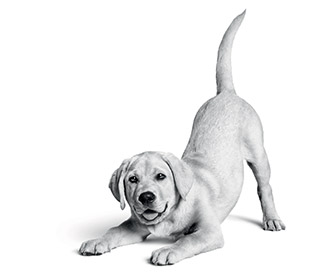When you first bring your puppy home, they will be entering your life and their new surroundings for the very first time.
To enable a puppy to develop the behaviour and skills required, it’s important to help them to settle into their environment with gentle training, socialisation and familiarisation as early as possible.
Essentially, socialising and training can have a huge positive effect on your puppy – but how should you socialise and train them?
Read on to find out how to socialise your puppy and discover the training tips we recommend for puppies.
Socialising to help them settle
Socialisation should take place whilst your dog is still a puppy and it should continue to be reinforced throughout adulthood.
It is generally accepted that your puppy’s socialisation period will start at birth and finish by the time they are around 16 weeks of age1.
The socialisation period is beneficial for your dog because it allows them to grow up having a better chance of dealing with unfamiliar people, animals and situations that they may encounter.
This means that you should familiarise your puppy with a varied range of sights and sounds to help them develop their acceptance of different situations which may arise. Here are some examples of how you can socialise your puppy:
- Always following your vet’s advice, especially before your puppy has completed its vaccinations, if you have friends with dogs that are healthy, well behaved and vaccinated, ask them to meet your puppy at your house or in a safe neutral space – making sure all interactions are safe for your puppy
- If your friends have children, allow your puppy to meet them – ensure interactions are gentle and closely supervised
- When appropriate on a venture outside, take your puppy with you – if your puppy is carried, they are less likely to encounter any concerns as a result of not yet being vaccinated and they should feel safe while they are being held
- There are a variety of pre-prepared noise recordings which you can use to expose your puppy to, which include storms, fireworks, balloons popping and noises that can lead to fear responses – these recordings can help your puppy become comfortable with loud noises
- Make sure your puppy gets used to being touched all over, check their feet and nails, brush their teeth and hair, check their ears and ensure that they familiar with being held
Puppies are more accepting and open to new experiences during the socialisation period. They are more likely to be inquisitive than frightened during this time of their lives. That’s why making the most of this period can yield amazing results.
Training for the long term
Puppies often bring a sense of fun, love and companionship to the home. However, the amount of effort you put into their training can define how well-behaved and adjusted they are to their daily lives and routines. Effectively-trained puppies are generally believed to be happier, more sociable and better behaved.
With house training, you should take your puppy to an appropriate location for going to the toilet often, and every time they do so, reward them with attention, food or a toy.
Take them out frequently for them to use the toilet – after play, feeding, exercise, entertainment, first thing in the morning, last thing at night, and at least once an hour. Stay with them so that you can reward them there and then, and if nothing happens wait a few minutes before you bring them in  and then try again in an hour.
and then try again in an hour.
Accidents will happen, but showing patience and perseverance should see your training succeed.
Puppies learn best by positive association, so if they do something and they are immediately rewarded with praise and a toy or food, they will be keen to repeat that action again because of its association with the reward.
Whatever you choose to teach your puppy during training, the best method is to keep your training sessions short (a few minutes only), fun and to complete multiple sessions a day, every day in multiple locations until your dog is competent in the training they have been taught.
Puppies can begin gentle and short periods of lead-training as soon as they have settled into their new routine. Five minutes at a time is generally more than enough for this and puppies should never be forced to walk or train if they are tired. If your puppy has not finished its vaccination course yet, lead-walking can be started inside the house or in the safety of your garden.
Lead walking
Firstly, decide upon which side of your body you want your dog to walk on and how far ahead of you they will be allowed to go. Then, have your puppy sitting by your side with its lead on and give the command for lead-walking as you set off, e.g. “Heel”. Reward your companion every few paces to encourage their behaviour.
If your puppy wanders too far ahead of you, stop moving and encourage them back to your side with a food reward before reinitiating the walk as before.
Vet advice
If you have any questions or concerns about puppy socialisation, training, or anything else related to your puppy, don’t hesitate to ask your vet for their professional opinion. As well as operations and consultations, their role also includes giving the best advice that they can on all puppy and pet-related topics.
- Duxbury MM et al. 2003.